November 2025
Sunday, November 9th in Latour de France…with Julie Boulanger
We had bought our house but not yet moved in; we were “gîte-surfing” while the renovations were taking too long. It was by chance that we went to check up on the progress on an overcast November day… and discovered that all the streets were closed off for village-wide festivities! It was the yearly Open Doors at Latour-de-France, and it is taking place again this coming Sunday, November 9th.
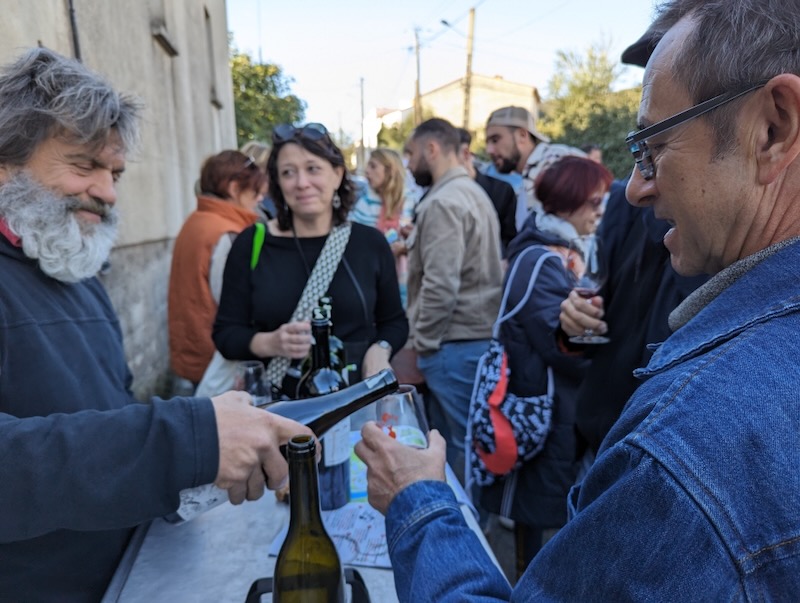
What are the Open Doors at Latour-de-France?
Every year at the beginning of November, local wine domaines open the doors to their cellars – sometimes the gates to their grounds, other times the garage doors that expose the wine vats hiding within – for tasting. In addition to the wineries from the village, small wine producers from other areas in France are invited to participate. This year, over 50 wineries are expected.
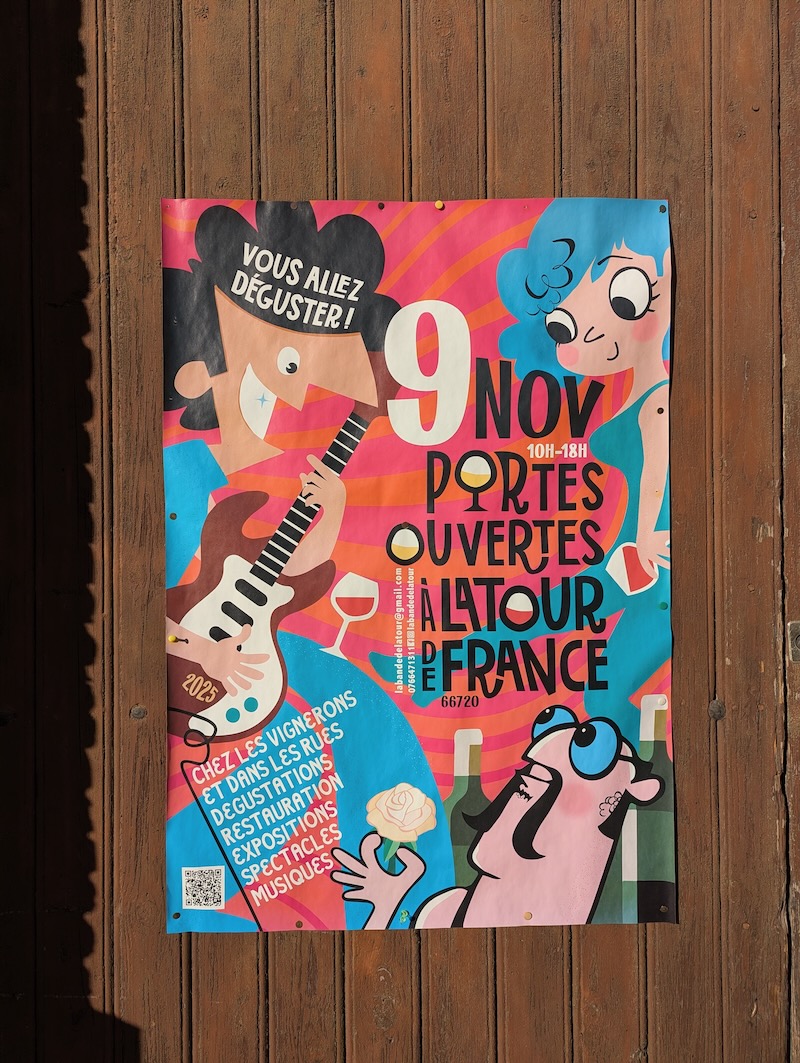
To join in the fun, purchase a tasting class for 10 € at the Terres Plurielles cooperative winery, at the entrance of the village. There is parking nearby, but no cash machine, so plan for cash and cheques.
Then, roam the village to discover the winding Medieval streets dotted with wine tasting stands, food trucks, musical bands, art, pottery and photography exhibitions, street performers, and a slew of other animations that make these days worth the visit.

If you fall in love with a wine or two (or three, or four), purchasing bottles is possible and will be coordinated behind the Terres Plurielles cooperative winery.
La Bande de Latour – The Organizers
You might have already seen the posters for these events with their bright colors and fun circus-type characters. Different from year to year but always on-brand.
These Open Doors are put on by La bande de Latour, a local association of organic winemakers (many of whom go a step further and make natural wines). Though festive is definitely part of their creed, they do more than host a village-wide party.
The La bande de Latour association allows for adhesion to a Coopérative d’Utilisation de Matériel Agricole, or CUMA, a cooperative that buys farming material, such as tractors, wine presses and plowing equipment, that can be used by its members. The CUMA also provides a shared-work employer group, for sharing field-work staff.
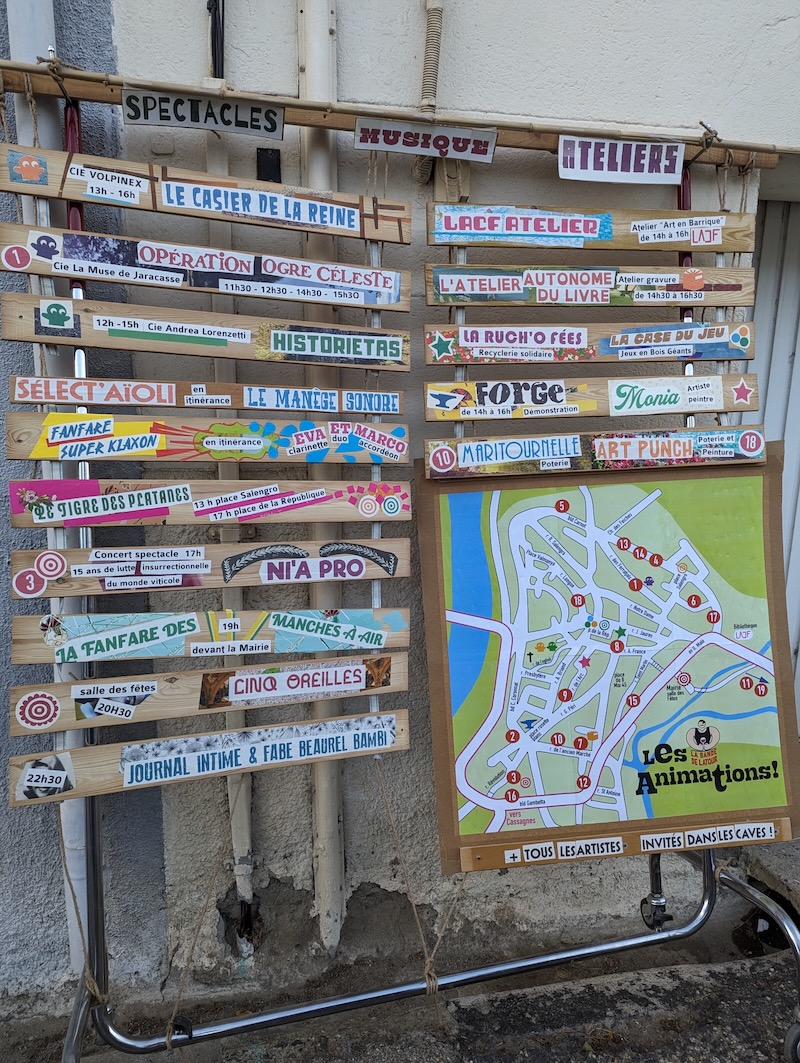
Where – and Why – Organic Wines Flourish
Latour-de-France is an Appelation d’origine controllée (AOC) that comprises wine made in that village as well as some of its neighbors (Cassagnes, Montner, Estagel, and Planèzes). Not all the wine produced here is organic, but the tendency is towards a softer approach to growing grapes and vinification. This is supported by its geography.
To begin with, the warm and dry weather (especially in the North of the department) acts as a natural barrier to one of the primary scourges to grape growing: mildew, a harmful fungus disease that spreads rapidly in humid conditions.
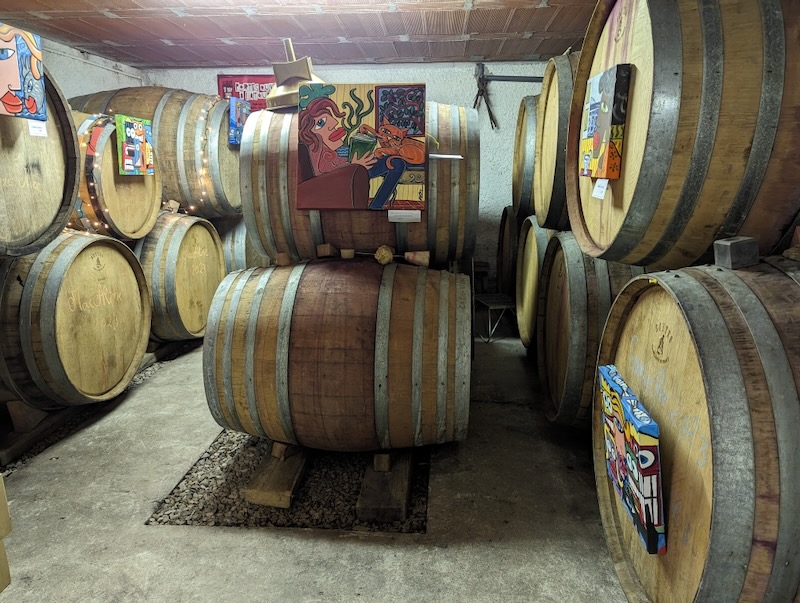
Then, there is our beloved Tramontane wind. As you have all surely experienced, this strong north-westerly wind fiercely blows leaves, dust and pollen. It also blows dry any critters or fungi that may wrongfully have believed to have found refuge in a bunch of grapes.
Finally, the farmland layout. Contrarily to the Bordeaux area where large plots of land belonged to a château, grape farmers in the Roussillon area were traditionally small landowners who worked their land and sold their produce to their local coopérative. There was little distinction between grape or ground variety, producing a sort of generic wine. (If you ever hear a French person complaining about the quality of the wine made here without having recently tasted it, they are most likely basing their opinion on hearsay from their grandparents.) As families grew, plots were divided among the children who kept up the trade, hence becoming smaller.
More recently, winemakers buy up or rent land in different locations, allowing them to grow different varieties of grapes on different types of soil. The hills and valleys in the area allow for different exposure to the sun. With these diverse elements scattered across fragmented plots, today’s winemakers have a rich palette to craft unique and expressive blends. This patchwork of plots also assists with the spread of organic farming.
As logic would have it, having organic farm practices amounts to nothing if the guy next door sprays his fields with pesticides. But if multiple organic winemakers all work on several spread-out parcels of land, the organic way eventually takes over. Especially as more winemakers interested in organic processes are attracted to the area and set up shop here.
The Evolution of Organic Winemaking – A Portrait
To get a better grasp of the history of wine making in this area and its shift towards organic production, I spoke with Didier Fabresse, a now retired winemaker who built his career in Latour-de-France.
The son and grandson of winemakers, Fabresse studied oenology. For the first five years of his career, he assembled wine for a cooperative and then a privately owned cellar. In 1989, starting off with three hectares of land, he launched his own business (and became the third independent winery in the village). This meant that in addition to assembling the wine, he now had to tend to the vines and commercialize his product.
He begun his career making what he calls “conventional wine,” which was the production process he had learned from his family. It was only in 2001, half-way through his career, that he pivoted towards organic winemaking, and the learning curve was steep. It took years for him to change over.
Pesticides were introduced to grape farming in France in the 1960s. At the time, they were considered miraculous. Fungus and weeds just died away. Laboring the fields became much easier and yields were high. It seemed like a win-win.
Fabresse notes that the biggest challenge when going from conventional to organic winemaking is the drop in productivity. Farmers must find ways to maintain their vines while avoiding overgrowth. Land parcels must be adapted for laboring, be it by hand, tractor or horse. Either way, the work is much more physical. Chemical fertilizers are substituted by manure, compost, and other natural methods. To fight mildew, a solution of diluted copper powder is sprayed on vines instead of harsher chemicals.
When I asked Fabresse what prompted him to take his winemaking practices organic, he said the health benefits were clear to him. Indeed, he witnessed generations of farmers before him suffer from Parkinson’s disease, generalized cancer, and acute liver cancer (this in a man who only ever drank water from the same glass).
In Latour-de-France, by 2015, organic winemaking took over. There are but a few conventional winemakers left, and many use less pesticides than they did in the past.
As for the Fabresse business, it was his choice to remain small. He did not export his wine. Instead, he sold his wines in farmers’ markets, small trade shows, and local restaurants. He retired in 2022.
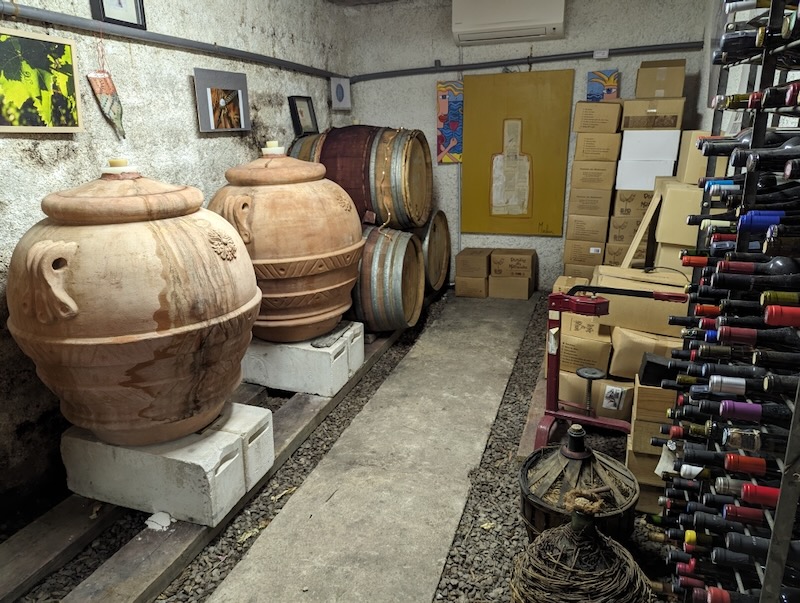
The Threats to Winemaking in The Pyrénées-Orientales
There are two main environmental threats to grape farmers in our area: drought and hail.
Hailstorms can occur anywhere from April to October. The landscape of fragmented plots does help; if a storm hits in one location, winemakers can depend on their vines from another plot of land. But this is not enough, which is why the département has invested in cloud-seeding.
There is a network across the département of around 50 anti-hail generators. They burn acetone infused with silver iodide crystals; the rising heat carries the particles into the atmosphere, where hail forms around them. The resulting hailstones are smaller than how nature would have it, therefore cause less damage to the vines.
As for droughts, we are all aware of the effects of lack of rain in the area. Climate change and water management are important issues within the département. Just last week (Monday, October 27th), they were addressed at the Departmental Winegrowing Conference, which was composed of more than a hundred participants from local and state organizations. Actionable solutions are still taking shape — and happily the momentum is growing.
La Bande de Latour can be found on Facebook and Instagram. Maps of the event can be downloaded from their social media sites and will be available at the event.
All photos were taken of past events in the village.
